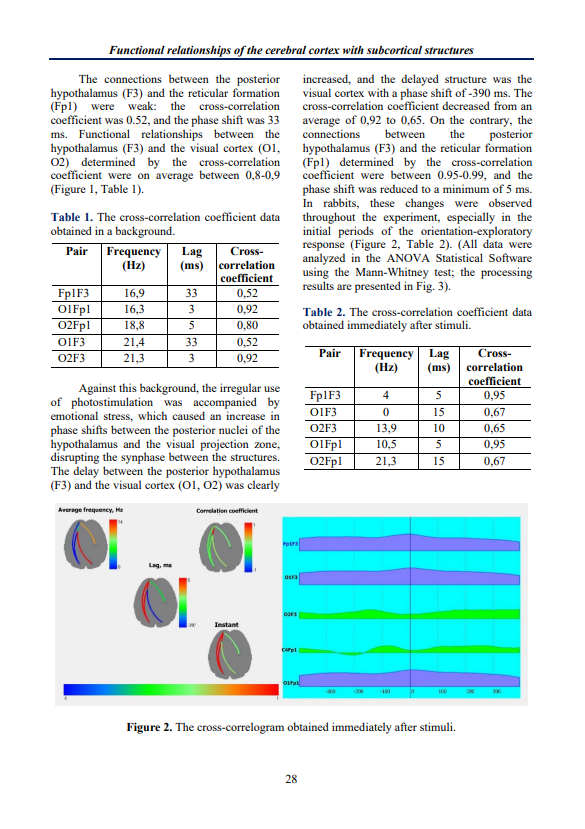Abstract
Multidirectional and stable changes in phase shifts and cross-correlation coefficients of the cortical and subcortical stress rhythms occur under conditions of repeated irregular photostimulation, especially in the initial periods. Thus, cross-correlation functional connections, characterized by changes in the spatio-temporal relationships of the brain structures (posterior nuclei of the hypothalamus, reticular formation, and visual projection zones of the cerebral cortex), can be one of the indicators of the formation of stress. By using the parameters mentioned above, we can solve many issues related to the central mechanisms of stress. Our results show that functional connections between the cortical projection area and subcortical structures decrease under stress conditions, while connections between subcortical structures increase. We furthermore found that these EEG changes correlated with autonomic reactions in animals. Thus, these changes may lie based on central mechanisms of stress, and the results of changes in the EEG activity of the cerebral cortex and the cross-correlation parameters in the posterior nuclei of the hypothalamus and the reticular formation may allow preventive measures to be taken to affect these structures to reduce emotional stress.
References
Gaino Gainotti G. A historical review of investigations on laterality of emotions in the human brain. J Hist Neurosci. 2019 Jan-Mar;28(1):23-41. https://doi.org/10.1080/0964704X.2018.1524683.
Kober H, Barrett LF, Joseph J, Bliss-Moreau E, Lindquist K, Wager TD. Functional grouping and cortical-subcortical interactions in emotion: a meta-analysis of neuroimaging studies. Neuroimage. 2008 Aug 15;42(2):998-1031. https://doi.org/10.1016/j.neuroimage.2008.03.059.
Kreibig SD. Autonomic nervous system activity in emotion: a review. Biol Psychol. 2010 Jul;84(3):394-421. https://doi.org/10.1016/j.biopsycho.2010.03.010.
Palomero-Gallagher N, Amunts K. A short review on emotion processing: a lateralized network of neuronal networks. Brain Struct Funct. 2022 Mar;227(2):673-684. https://doi.org/10.1007/s00429-021-02331-7.
Prete G, Capotosto P, Zappasodi F, Laeng B, Tommasi L. The cerebral correlates of subliminal emotions: an eleoencephalographic study with emotional hybrid faces. Eur J Neurosci. 2015 Dec;42(11):2952-62. https://doi.org/10.1111/ejn.13078.
Salari N, Hosseinian-Far A, Jalali R, Vaisi-Raygani A, Rasoulpoor S, Mohammadi M, Rasoulpoor S, Khaledi-Paveh B. Prevalence of stress, anxiety, depression among the general population during the COVID-19 pandemic: a systematic review and meta-analysis. Global Health. 2020 Jul 6;16(1):57. https://doi.org/10.1186/s12992-020-00589-w.
Selye H. Forty years of stress research: principal remaining problems and misconceptions. Can Med Assoc J. 1976 Jul 3;115(1):53-6.
Tran Y, Thuraisingham RA, Wijesuriya N, Nguyen HT, Craig A. Detecting neural changes during stress and fatigue effectively: a comparison of spectral analysis and sample entropy. Proceedings of the 3rd International IEEE EMBS Conference on Neural Engineering. Kohala Coast, Hawaii, USA, 2007 May 2-5; 350-353. https://doi.org/10.1109/CNE.2007.369682.
Valenza G, Citi L, Lanatá A, Scilingo EP & Barbieri R. Revealing real-time emotional responses: a personalized assessment based on heartbeat dynamics. Sci. Rep. 2014; 4: 4998.

This work is licensed under a Creative Commons Attribution 4.0 International License.
Copyright (c) 2023 Azerbaijan Journal of Physiology




